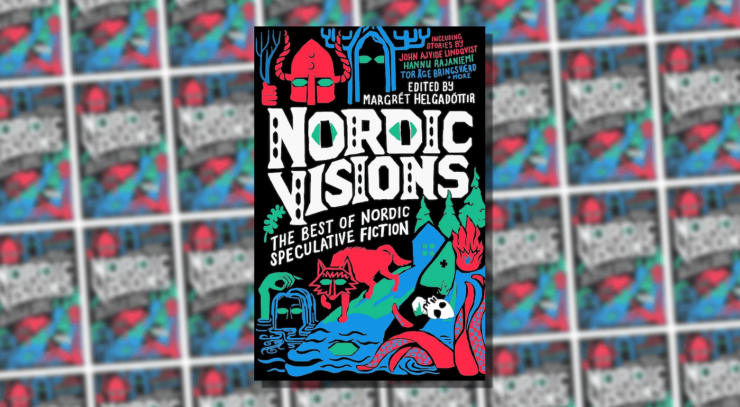Nordic Visions is an anthology of speculative fiction stories written by Nordic authors and edited by Margrét Helgadóttir. Released by Solaris Books in the fall of 2023, the book’s sixteen short stories are drawn from all of the Nordic nations and the Faroe Islands, an autonomous territory of Denmark. Taken as a whole, the anthology presents a compelling cross-section of original sci-fi, fantasy, and horror originating in a part of the world best known internationally for crime fiction and children’s books.
Helgadóttir’s introduction provides an informative overview of Nordic speculative fiction as a whole and positions the genre within the broader context of the Nordic literary tradition, while also delineating some of the cultural and historical differences found in each of the countries comprising the region. The short stories themselves are organized by country and they cover a wide range of themes—readers will encounter ghosts, far-flung planets, dystopian societies, mythological characters, fairy tale enchantments, and more. While covering a broad range, the selection of stories leans a bit heavier towards science fiction than fantasy, and some entries are, naturally, stronger than others (as is generally the case with any collection or anthology).
Buy the Book


Nordic Visions
Nonetheless, Nordic Visions provides an excellent introduction to writers of speculative fiction from a region that tends to be overlooked in the genre. Most of the authors featured have also written full-length novels, many of which have been translated into English. A short bio of each author is provided at the end of the book, which serves as a useful guide for anyone who might wish to check out more of the selected authors’ other works. And if you’re interested in seeking out longer works of Nordic speculative fiction, be sure to also check out my earlier piece on “Exploring Nordic Speculative Fiction in Five Novels.”
Without further ado, here’s an overview of some of the many highlights found in Nordic Visions…
“She” by John Ajvide Lindqvist
A very clever little story that opens the anthology after Helgadóttir’s introduction. Written by the only author in the collection to have made a bit of a splash in English language literature (Lindqvist is the author of Let the Right One In), “She” is essentially a ghost story centered around the haunting of a new house built by a married couple in Sweden. As tends to be Lindqvist’s habit, he subverts the usual tropes of his chosen genre, in this instance by connecting the narrative to the horrors of World War II and shining some light on the darker side of modern Swedish history in the process.
“Sing” by Karin Tidbeck
“Sing” is a futuristic story set on the former mining planet of Kiruna (anyone familiar with Sweden should appreciate the name) that’s dominated by a parasitic ecosystem. The story follows the companionship of Aino, an outcast tailor, and Petr, a temporary visitor to Aino’s tiny village. Petr can’t communicate in the planet’s native “singing” language and as he digs deeper into how he might learn it, the disturbing nature of the planet’s ecosystem is revealed. “Sing” originally appeared on Reactor (then Tor.com) in 2013 and can be read here.
“The Cormorant” by Tone Almhjell
“The Cormorant” is Nordic Visions’ ode to the fairy tale, and is in fact based on one from the early 20th century by Regine Normann, who was something of a Norwegian Hans Christian Andersen (thus the tale is a modern age original story rather than a Grimm Brothers- or Asbjørnsen/Moe-style record of a much older one). “The Cormorant” follows a mother and daughter who live apart in isolation from the rest of their coastal village until an innocent but pivotal act triggers a chain reaction that upends their lives. A thickening sense of mystery propels the story forward towards a very effective, magical, and somewhat unsettling conclusion.
“A Bird Does Not Sing Because It Has an Answer” by Johanna Sinisalo
Johanna Sinisalo, the author of Troll: A Love Story and the original story behind the film Iron Sky, is a highly original sci-fi writer and “A Bird Does Not Sing Because It Has an Answer” is no exception. This story is set in a future with very few wilderness areas remaining and focuses on a single character who is responsible for using advanced electronics to study the behavior of birds… but of course, things don’t go quite as they should. This one is very compelling and ends on a wonderfully twisted note of cynicism.
“The Wings That Slice the Sky” by Emmi Itäranta
“The Wings That Slice the Sky” is a splendid little retelling of The Kalevala, the Finnish national epic and primary source of Finnish mythology. It starts with a description of the painting The Defense of the Sampo by Akseli Gallen-Kallela, which visually depicts Louhi, the story’s first-person narrator, as she is typically portrayed: a wicked, winged monster. The following pages then proceed to tell Louhi’s side of the story. “The Wings That Slice the Sky” is basically Finland’s answer to Genevieve Gornichec’s retelling of Norse mythology in The Witch’s Heart, only provided in short story form rather than a full-length novel.










